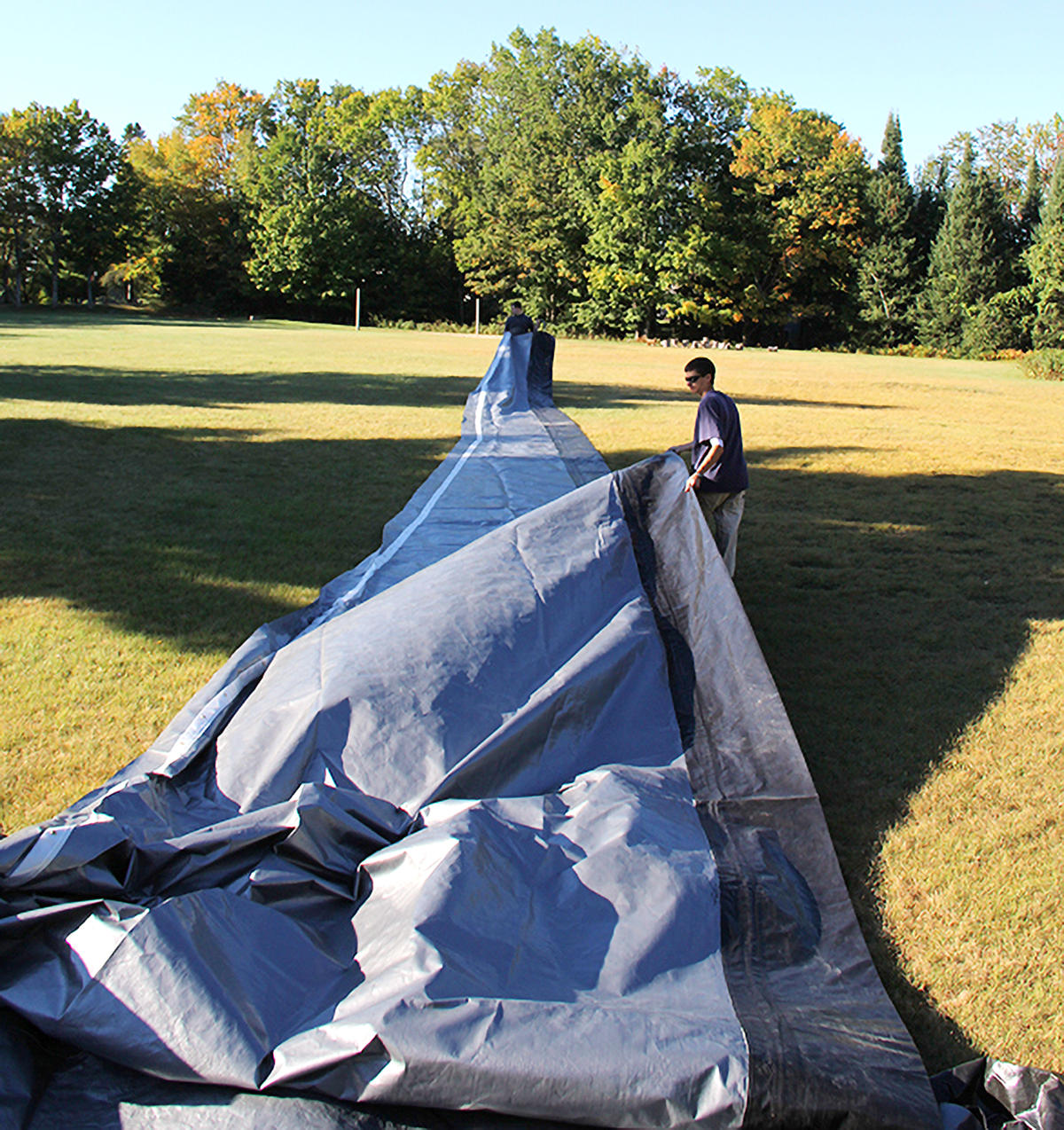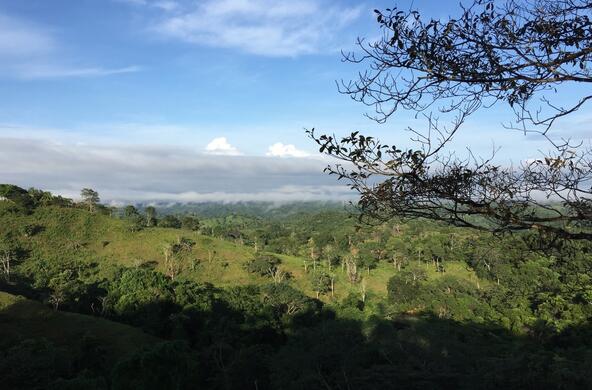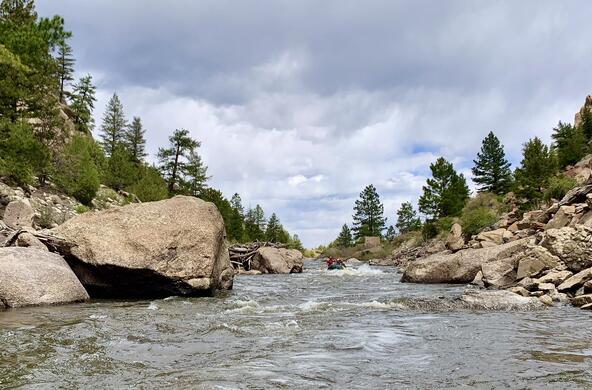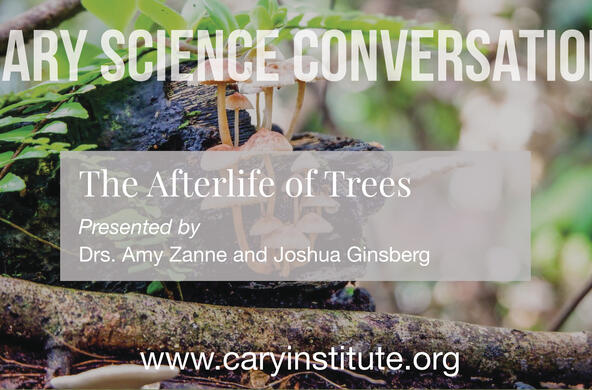Many lakes across the northern hemisphere are getting darker; causes include heavier rains, changes in land use patterns, and recovery from acid rain. Understanding how lake browning impacts fishery productivity is an area of research for Cary Institute ecologist Chris Solomon.
Tree leaves, pine needles, and other land plant parts are washed into lakes by streams and runoff waters. This material breaks into tiny particles – called dissolved organic carbon (DOC) – that can give lakes a brownish tint. In high concentrations, DOC has been found to reduce photosynthesis, altering the aquatic food web to the detriment of resident fish.
In an effort to better understand the relationship between DOC and fish productivity, Solomon and his collaborators split a lake in half – one side DOC-rich, the other DOC-poor – and spent five years documenting how bass responded. Their results, in the Canadian Journal of Fisheries and Aquatic Sciences, reveal the complexity of the issue.
Solomon explains, “The existing body of literature indicates that increasing DOC has a negative effect on fish populations. Several years into our study, we were surprised to find strong contradictory trends, which strengthened over the project’s five-year span.”
Long Lake at the University of Notre Dame Environmental Research Center in Michigan was the site of the study. The hourglass-shaped lake is made up of two basins connected by a shallow shelf; a stream feeding its eastern shore is the lake’s main DOC source. By anchoring a high-density polyester curtain to the lake floor, the team separated the basins at the pinch of the hourglass.
Once divided, DOC accumulated in the ‘treatment’ basin, while the ‘control’ basin received minimal DOC inputs through snow, rain, and runoff. Largemouth Bass (Micropterus salmoides) comprise 97% of Long Lake’s fish stock. For five years, the team collected data on bass abundance, diets, growth rates, body condition, and depth distribution on each side of the lake.
Adult bass fared better in the DOC-rich treatment basin, while juveniles thrived in the DOC-limited control basin. Understanding these mixed results requires taking a closer look at both the food web and fish behavior. Phantom midges and cannibalism are central to the story.
In lake food webs, phytoplankton (tiny plants) derive energy from the sun and are a key food for zooplankton (tiny animals). DOC-induced light limitation was expected to reduce photosynthesis on the treatment side of the lake, yet phytoplankton productivity increased.
Solomon explains, “Zooplankton can make use of increased DOC by eating bacteria that feed on DOC; however, the increase in phytoplankton on the treatment side – despite the darker water and lower light levels – was likely due to DOC’s impact on lake temperature and stratification.”
Lake water columns are comprised of distinct layers defined by temperature – a phenomenon called stratification. DOC effects light penetration, and as a result, lake temperature and the depths of these layers. Increased DOC causes the topmost layer, the epilimnion, to become shallower. This is the layer in which phytoplankton circulate. When the epilimnion is condensed, phytoplankton rise and fall more quickly within it.

While light could not penetrate deep into the water column on the treatment side of the lake, rapid phytoplankton circulation in the epilimnion allowed phytoplankton to be exposed to just as much total sunlight as phytoplankton on the control side. Treatment phytoplankton also had access to more nutrients, which entered the lake with DOC. Plentiful zooplankton boosted the abundance of midges (Chaoborus), which was a boon for fish.
Shuntaro Koizumi, lead author and current PhD candidate at Umeå University explains, “Midges became an important food source for fish on the treatment side of the lake, giving them an advantage over the control populations, which did not have access to this plentiful food resource. As a result, fish productivity increased with elevated DOC concentrations. This was a surprising twist.
But the story doesn’t end there. As fish in the treatment basin feasted on midges, lean times in the control basin likely incited a behavior that magnified the discrepancy in food resources between the two sides of Long Lake: cannibalism.
“It is not uncommon for cannibalistic cycles to emerge in unfished lakes,” says Solomon. “High numbers of adult fish require robust sources of nutrition. Food demand can outstrip the availability of typical food sources.”
To adult bass on the brink of starvation, just about anything looks good to eat – including baby bass. If the adult population remains stable and food remains scarce, this behavior can continue – sometimes for many years – until adults start dying off. As fish densities decrease, the system will eventually reach a point at which food is again plentiful and young fish are able to mature.
Koizumi says, “A stable adult population with unsuccessful juvenile development is not a sustainable population model in the long term. By increasing DOC in the treatment basin, we supplemented food abundance and likely delayed cannibalistic behavior. It’s important to underscore ‘delay’ here. Adding DOC to lakes isn’t set to become a strategy for boosting fish stocks.”
Alterations to lake food webs are but one symptom of DOC enrichment. Browning freshwater gives rise to concerns around drinking water quality as it is more difficult and expensive to process for safe human consumption. Plus, light limitation in the water column suppresses natural disinfection processes (ultraviolet radiation helps inactivate waterborne pathogens). Since carbon dioxide is a byproduct of plant decomposition, DOC-rich water bodies also produce more greenhouse gases than those which are DOC-poor.
Understanding the many impacts of DOC variation in lakes – and the factors that give rise to these variations – is key to developing effective management strategies and maintaining the health of aquatic ecosystems and their services.
Recent funding from the National Science Foundation will support the team for an additional five years as they continue to explore shifts in the Long Lake ecosystem in response to increasing DOC loads. Solomon says, “DOC inputs vary widely across the landscape – from lake to lake and over time. We want to know what these variations mean for lake functioning.”
Findings from the first five years of the study will be used to evaluate the accuracy of models designed to predict changes in lake ecosystems in response to factors like increasing carbon loads, nutrient inputs, and light limitation. In addition to fieldwork and surveys, these models will be tested using ‘mesocosm’ experiments carried out in experimental tanks, which function as miniature lake ecosystems. The team will test their models on multiple geographic scales ranging from the immediate study region to lakes around the world.
Solomon explains, “In the next phase of this project, we’re aiming to determine whether our models can describe patterns that are consistent for other lake systems – across different regions, timescales, and lake sizes. Once these models are fine-tuned, they could help us understand how watershed-scale processes – particularly human alterations like nutrient pollution and changes in hydrology driven by climate change – influence lake productivity, water quality, and fisheries production.”
Citation
Experimental whole-lake dissolved organic carbon increase alters fish diet and density but not growth or productivity
Mr. Shuntaro Koizumi, Dr. Nicola Craig, Dr. Jacob A. Zwart, Dr. Patrick T. Kelly, Mr. Jacob P. Ziegler, Dr. Brian C Weidel, Dr. Stuart E. Jones, Dr. Christopher T. Solomon. Canadian Journal of Fisheries and Aquatic Sciences, 0, 0, https://doi.org/10.1139/cjfas-2017-0283







